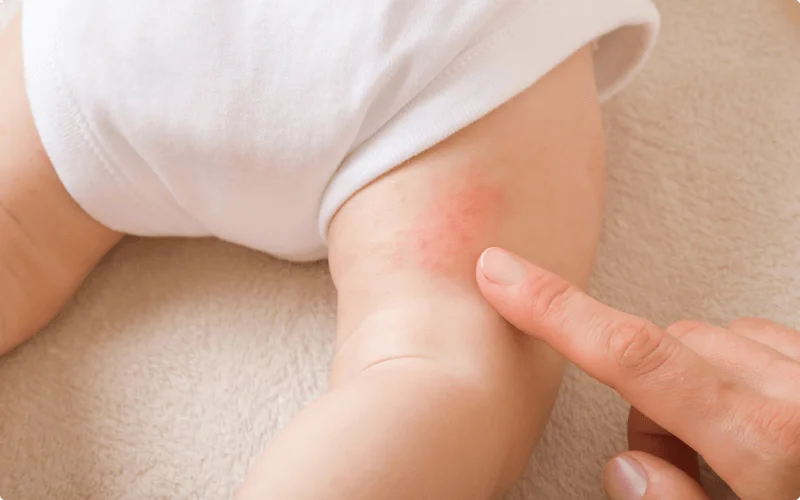How breast milk shields babies from developing allergies
This article is based on a recent study conducted by a team of researchers from Penn State College of Medicine, regarding the impact of tiny molecules present in breast milk on the immunity of infants.

Introduction
A recent scientific study has unravelled how breast milk has a component to it that can protect your infant from allergies1. Newborns are often affected by Allergies since they are new to the constantly changing outer environment. So, parents with a newborn and those planning to have a newborn must pay attention to this aspect of ‘breastfeeding’.
Background
What are allergies and atopy?
Allergy or atopy arises when the body’s immune system begins to fight against normally harmless substances, treating them as if they are some kind of harmful virus. Symptoms such as runny nose, sneezing, wheezing, itchy skin, rashes, and red, swollen, and watery eyes can be seen when there’s an allergic reaction occurring in the body.
Today approximately one-third of children are affected by atopic conditions like food allergies, asthma, and atopic dermatitis/ eczema (characterized by dry, itchy, and inflamed skin condition)
What are miRNAs and how do they work?
Researchers have discovered that tiny molecules called microribonucleic acid (microRNA/miRNA) especially in human breast milk (which was earlier thought to have no special function), have the ability to regulate gene expression in the infant thereby obstructing the allergic reaction occurring in the infants’ body2.
In breast milk, there are 1000 different kinds of miRNAs with varying compositions depending on the mother’s characteristics like weight, diet, and genetics. Based on experiments, researchers assume that four of these miRNAs can have a protective effect against allergies caused in infants by regulating gene expression1.
What are the benefits of breastfeeding for infants and mothers?
Breastfeeding or nursing an infant will be beneficial for both the mother and the baby.
- Breast milk provides necessary nutrients in the required proportion according to your baby’s growing needs. This is hardly achieved in any other formulated milk.
- Also, breast milk boosts your baby’s immunity and its contents are easily digestible in the infant.
- Breastfed children are less likely to be overweight or obese, and are less prone to diabetes and allergies, and atopic conditions.
- Breastfeeding is also good for mothers as it helps the uterus to return to its pre-pregnancy size, and it reduces the risk of developing breast cancers, ovarian cancers, cardiac diseases, obesity, and osteoporosis.
Even though breastfeeding might be challenging at times like developing sore nipples, engorged breasts, low breast milk supply, an overabundance of milk supply, and getting accustomed to the change in routine, with the intake of the proper nutrients, sleep, self-discipline, and support from your partner and family in maintaining a stress-free mentality, you can bring up a happy and a healthy child with very little disease complications into the family.
Method of research
In the study conducted at Penn State College of Medicine, Dr. Steven Hicks, associate professor of pediatrics and pediatrician states that infants who are breastfed beyond three months have a lower risk for atopic conditions like food allergies, asthma, and atopic dermatitis, but the biology behind this is not fully understood yet.
Based on prior studies demonstrating relationships between miRNAs and allergic conditions and the presence of miRNAs in breast milk Hicks assumes that these molecules (especially the 4 types of miRNAs) can be useful in reducing infant allergies. And the research was made in relation to it.
The research was done on 163 mothers breastfeeding for at least 4 months and their infants were supervised from birth to up to 12 months. Researchers tracked the duration each baby was breastfed and measured the miRNA composition of each mother’s breast milk over the course of lactation in 0, 4, and 16 weeks of breastfeeding.
Amounts of specific miRNA consumed by the infants were calculated based on feeding patterns and types of miRNA concentrations in the mother’s milk samples.
Results
Infants were monitored for atopic dermatitis, food allergies, and wheezing throughout the study.
It was found that out of 163 Infants, 73 developed atopic conditions (41 with atopic dermatitis, 33 with food allergy, and 10 with wheezing. Further, 11 infants developed more than one condition) and the rest did not develop atopy. All infants under research had no differences in maternal traits, infant traits, or environmental exposures.
Infants who did not develop atopy had consumed greater amounts of miRNA type: miRNA-375-3p (miR-375). Also, it was found that miRNA levels increased throughout lactation in the breast milk samples, and in addition, mothers with low BMI (Body Mass Index) had a higher concentration of miR-375.
Implications and conclusion
As per the research conducted, it is evident that breast milk contains tiny molecules called miRNAs that can reduce the likelihood of infants developing allergic conditions like atopic dermatitis and food allergies.
- Infants who breastfeed beyond three months may have a lower risk for these conditions because the content of one specific miRNA (miR-375) increases throughout lactation.
- MiR-375 (in breast milk) can regulate gene expression in the infant and modulate the immune system and gut microbiome, which are crucial for oral tolerance and health.
- It also suggests that maternal characteristics like weight, diet, and genetics can influence the composition of breast milk miRNAs.
- Mothers with a lower body mass index tend to have a higher concentration of miR-375 in their breast milk.
Therefore, mothers and potential mothers should be aware of the benefits of breastfeeding for themselves and their babies. Breast milk is not only a source of nutrition and hydration, but also a powerful tool for allergy prevention.
References
- Hicks SD, Beheshti R, Chandran D, Warren K, Confair A. Infant consumption of microRNA miR-375 in human milk lipids is associated with protection from atopy. Am J Clin Nutr. 2022;doi: https://www.sciencedirect.com/science/article/abs/pii/S0002916523036985?via%3Dihub
- Gómez-Gallego C, Collado MC. Breast Milk MicroRNAs: Potential Players in Oral Tolerance Development and Immune System Modulation During Early Life. Front Immunol. https://www.frontiersin.org/articles/10.3389/fimmu.2023.1154211/full
Ask a Dermatologist
Anonymous, fast and secure!

The Specialist doctor from the University Hospital in Gothenburg, alumnus UC Berkeley. My doctoral dissertation is about Digital Health and I have published 5 scientific articles in teledermatology and artificial intelligence and others.


